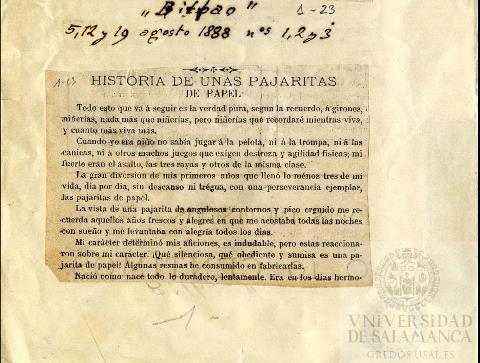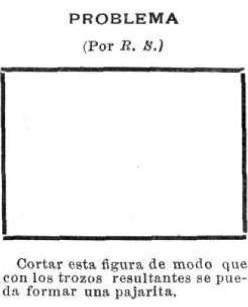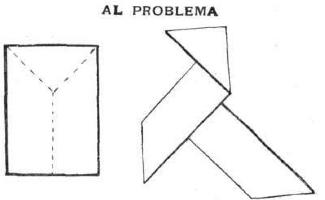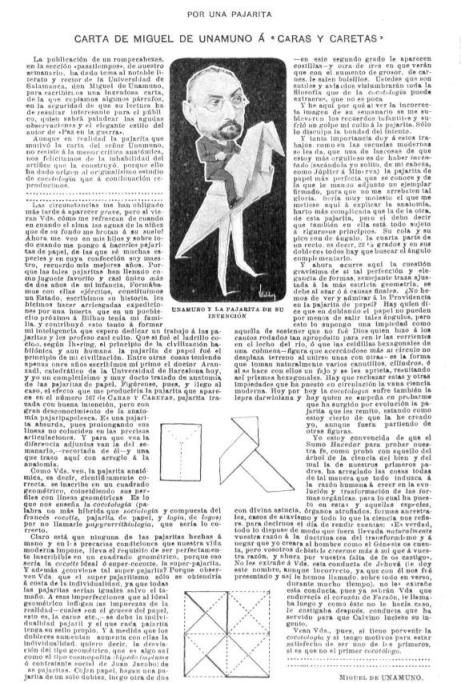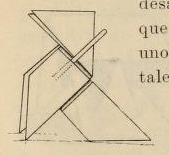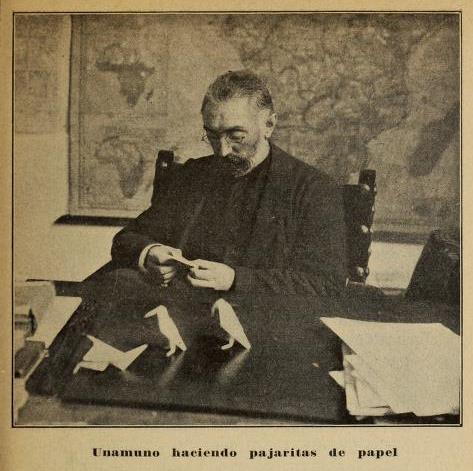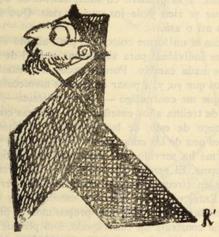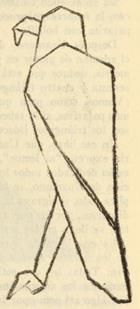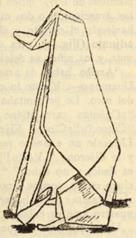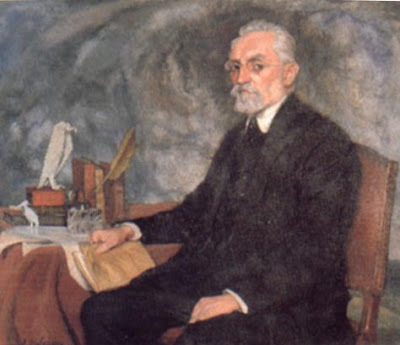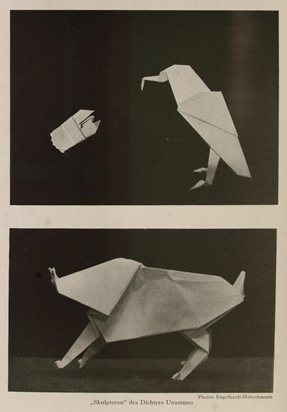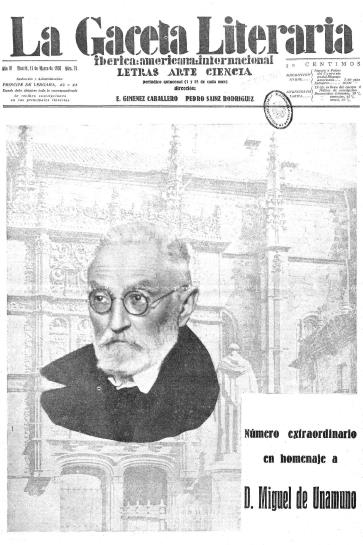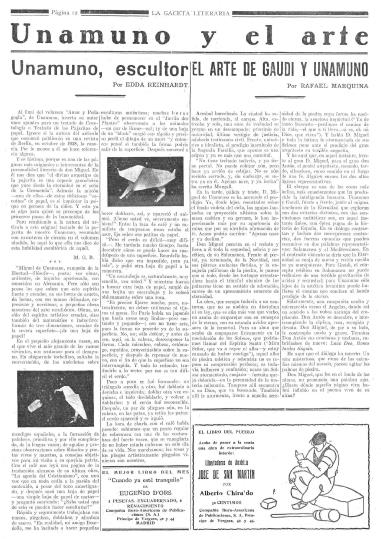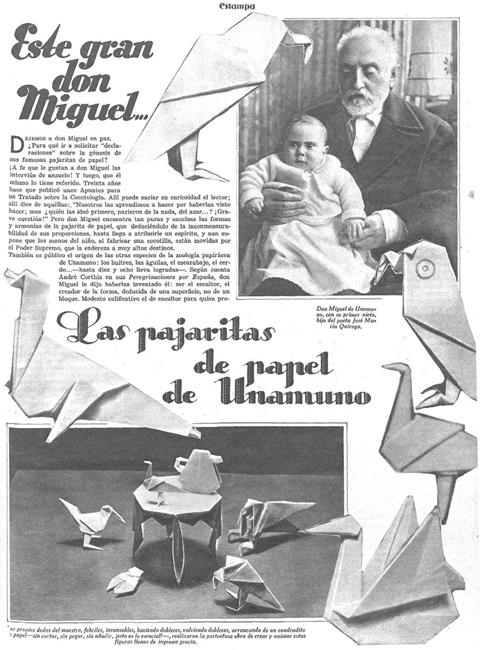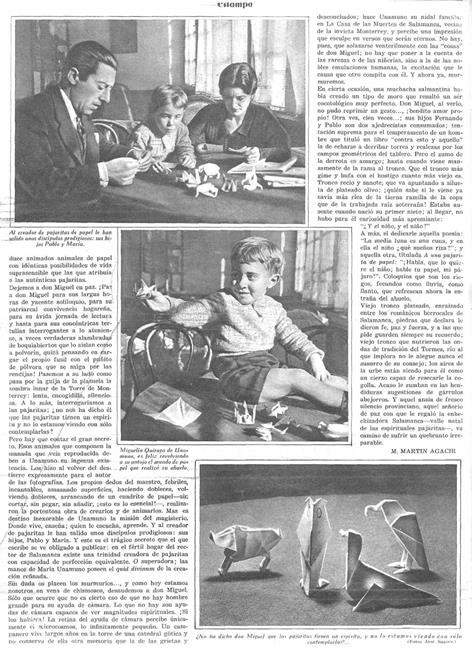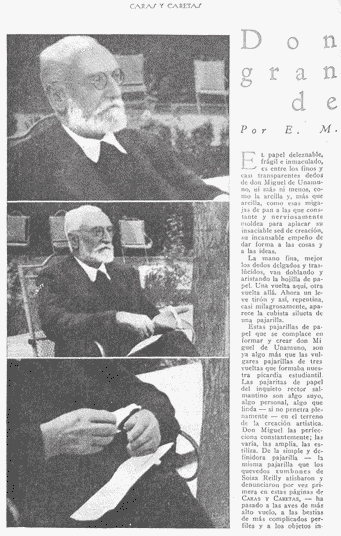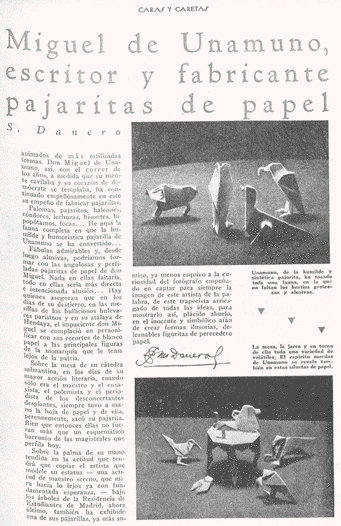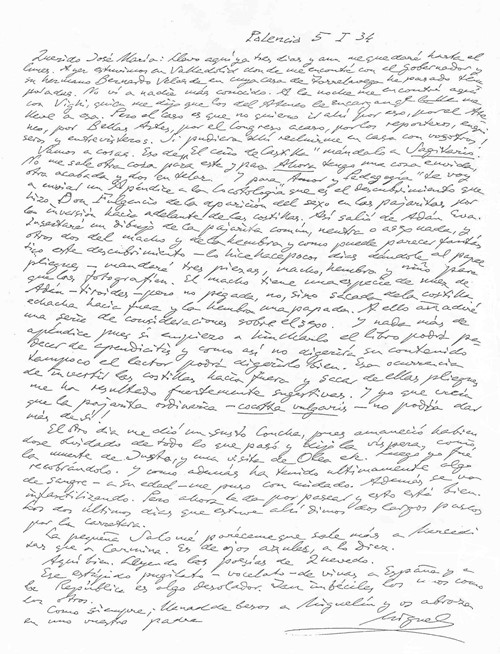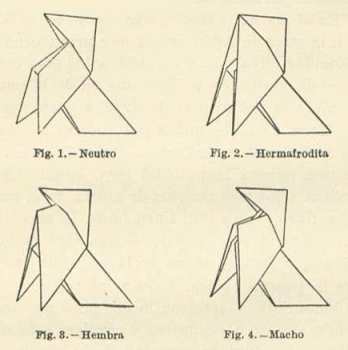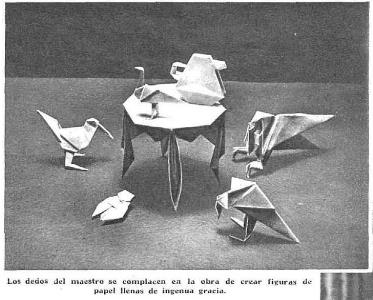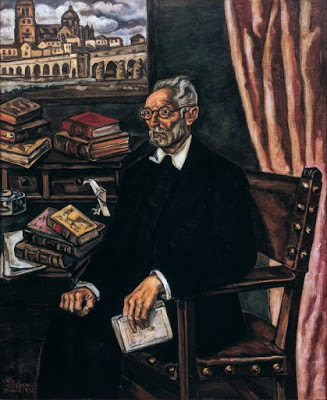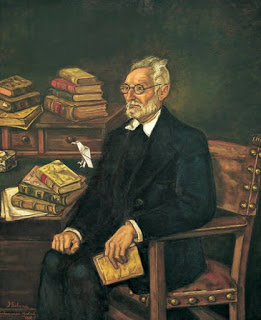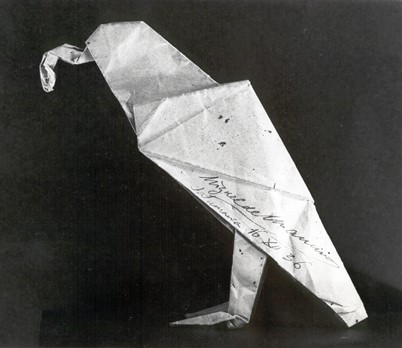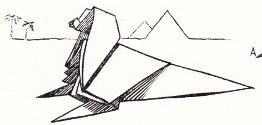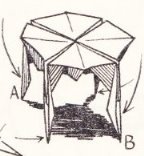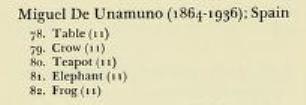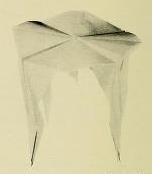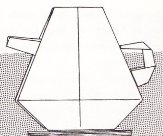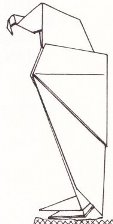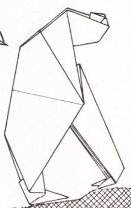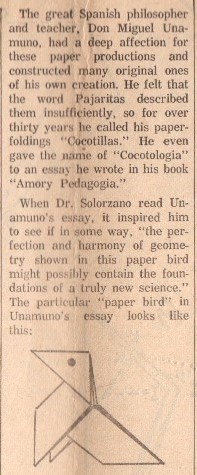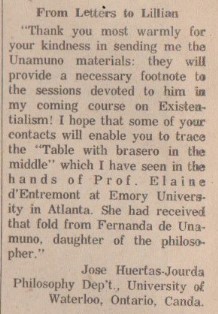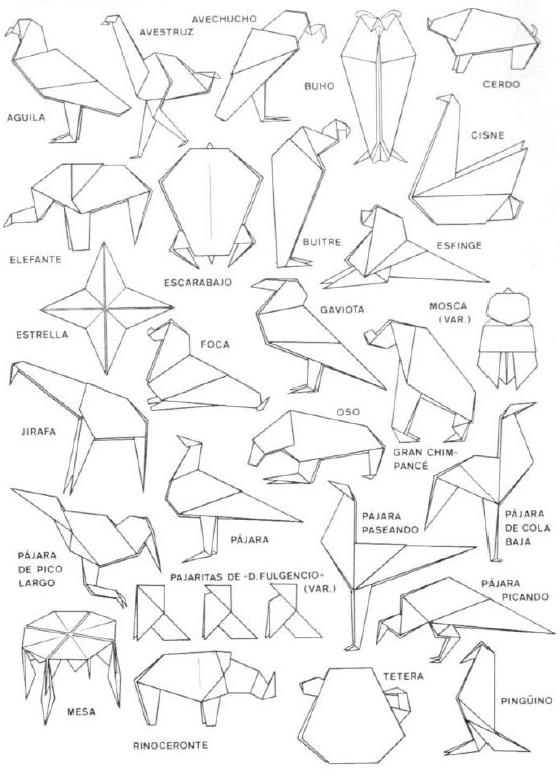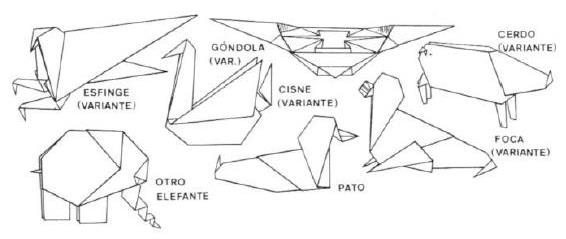| The Public Paperfolding History Project
Last updated 18/2/2025 x |
|||||||
| The Paperfolding of Miguel de Unamuno | |||||||
| Please
contact me if you know any of this information on this
page is incorrect or if you have any other information
that should be added. Thank you. The vast majority of the information on this page has been provided by Juan Gimeno. It could not have been written without his help. However, any errors or omissions are mine alone. There is a separate page about The Paperfolding Designs of Miguel de Unamuno. ********** Introduction Miguel de Unamuno was a Spanish academic, author and thinker who was also influential in the development of paperfolding in Spain and beyond, particularly because of his creative use of the bird base. The first section of this page provides a chronology of the main mentions of paperfolding in his own writings, contemporary magazine articles, photographs and paintings. The second section sets out the evidence to substantiate his authorship of designs attributed to him. We know from Don Miguel's own writings that he folded Pajaritas as a child, and created his own 'female' variation. He created other variations at a later date but his original designs are mostly developed from the bird base. It is most likely that he learned the bird base by folding the Flapping Bird although there is no direct evidence to this effect. We have evidence from a drawing in 'Cuestiones de Pedagogía Práctica: Medios de Instruir' by D Vicente Castro Legua that the Flapping Bird was known in Spain as early as 1893. An article entitled 'Pajaritologia', by Senesio Delgado, which uses the folding of Cocottes / Pajaritas to make points about art and contemporary thought, was published in the Spanish satirical magazine 'Madrid Comico on 13th January 1894. It is possible that this inspired or influenced Don Miguel in the writing of his much more famous 'Apuntes para un tratado de cocotologia'. If so it may also explain why Don Miguel chose to use the word 'cocotologia' rather than the more obvious 'pajaritologia' in his own writings. There is, however, no evidence that Miguel de Unamuno was aware of the earlier work. ********** Chronology Miguel de Unamuno was born in Bilbao on 29 September 1864. ********** 1888 'Historia de Unas Pajaritas de Papel', is an account, in three parts, of how, in 1874, when Don Miguel would have been 10, he and his cousin, who is not named here, folded and played with paper pajaritas and other toys during the bombing of Bilbao during the Third Carlist War. This account was published in the magazine 'Bilbao' on 5th, 12th and 19th August 1988. The original typewritten manuscript is now held in the archives of the University of Salamanca. The full document can be viewed at https://gredos.usal.es/bitstream/handle/10366/84004/CMU_1-23.pdf?sequence=1
A transcript of the full original Spanish text (courtesy of Juan Gimeno) and a complete rough English translation can be found here. The paper birds Don Miguel writes about in this account are referred to as 'pajaritas de papel' (little paper birds) except on one occasion he refers to them as 'pajarillos' (also meaning little birds). It seems clear from the context that these paperfolds are the familar Cocotte / Pajarita design. 'It was in the beautiful days of the spring of 1874, during the bombing of my village. Something had to do with spending time in the dark, damp fish market that needed daylight, for the only doors open to it had been boarded up with mattresses. We heard nothing but the army, battles, Carlists and Liberals, bombs and assaults and the only thing that happened to us was to make about two hundred sparrows (pajarillos) (in France they are cocottes), train them four deep and simulate combat.' 'Originally those original birds lived in the wild, without police or hierarchical order, without their name or occupation, without a fixed residence, wandering from here to there, from box to box, and what is more surprising, without females nothing worth it, because this was born later. They were produced autonomously and by spontaneous generation, informed by my hands and those of my cousin, their creators, of the raw material of a white paper.' Don Miguel states that the Cocottes / Pajaritas that he and his cousin folded were of two types, folded from doubly and triply blintzed squares: 'There were two breeds, a slimmer and slimmer, made of two doubles, and a thick, bearded and pocketed, made of three.' Don Miguel characterises the basic 'pajarita de papel' design as male and explains that he and his cousin also devised a female version by 'raising its beak'. 'Death was already regularized, but birth was not, because, frankly, being born by birlibirloque, by spontaneous generation, is a corny thing. So we thought that it was not right for the bird to be alone and we devised a companion similar to him. By raising its beak, the way its legs are made, instead of lowering it, the female was already invented. And from then on we made the birds, we folded their beaks inwards and thus they were placed between the folds of the females until the latter, with the bustle of going and coming back, were released, that is, they gave birth.' ********** 1889 Don Miguel visited the Exposition Universelle in Paris in 1889 . We know from an article in Issue 852 of 'La Nature' for 28th September 1889 that the Japanese Pavilion at this exhibition contained a display of origami designs folded by Japanese schoolchildren, which included the Inflatable Frog. However, there is no evidence to show that Unamuno visited the Pavilion or saw this display. His writings contain no evidence that he knew of the Inflatable Frog design. There is also no evidence that Unamuno encountered the Flapping Bird, and thus the bird base, during this visit. ********** 1890 In December 1890 Don Miguel wrote a letter to Juan Azardun (Juan Arzadun Zabala (1862-1950) who was a childhood friend of his, a career soldier but also a poet and playwright) in which he mentions pajaritas 'that fly', which is possibly, but not necessarily, a reference to the Flapping Bird. In the original Spanish: 'Los que se me pegan y no me sueltan, son los chiquillos. ¡Oh, lo que me gustan! Le desafío a cualquiera a quién sabe hacer mejor pajaritas, de las que vuelan y de las que no vuelan.' Roughly in English: 'Those who stick to me and don't let go are the kids. Oh what I like! I challenge anyone who knows how to make better pajaritas, the ones that fly and the ones that don't.' In the same letter he also mentions other kinds of paperfolds: In the original Spanish: '... mesas, barcos, bonetes, gorros, fuelles, globos, todo en papel; a quién mejor coloca la mosca en la pajarita, a quien hace mejor un muñeco que baile'. Roughly in English: '... tables, boats, bonnets, hats, bellows, balloons, all on paper; who better places the fly in the pajarita, who makes a doll better than dancing'. See entry for 1908 below for an explanation of the reference to 'the fly in the pajarita'. ********** 1897 Don Miguel's first novel, 'Paz en la guerra' was published in 1897. The novel includes a brief reference to his childhood experiences making Cocotte / Pajaritas as recorded in the 'Historia de Unas Pajaritas de Papel' when he writes: 'Para los niños empezó con el bombardeo nueva vida de hermosos días de holguería, sin colegio. Divertíanse Marcelino y los hermanos de Enrique en armar ejércitos de pajaritos de papel, y cuando una bomba caía cerca, salían a recoger los aún calientes cascos.' In English: 'For the children, new life began with the bombardment of beautiful days of idleness, without school. Marcelino and Enrique's brothers had fun in assembling armies of little paper birds, and when a bomb fell nearby, they would go out to collect the still warm helmets.' ********** 1901 Issue 166 of the magazine 'Caras y Caretas' (Faces and Masks), published in Buenos Aires on 7th December 1901, included a puzzle to cut a rectangle into pieces that when rearranged would form a Cocotte / Pajarita.
********** The solution was published in issue 167 on 14th December 1901.
*********** 1902 In response to this solution, and in particular to the misproportioned drawing of the Cocotte / Pajarita, Don Miguel wrote a letter to the Editor which was published, under the title of 'Por una Pajarita, in issue 178 of 1st March 1902.
A full readable version of the article can be found here. Much of the information is similar to that given in his earlier articles, 'Historia de Unas Pajaritas de Papel' and in the 'Apuntes para un tratado de cocotología' (see below), which had, of course, already been written by this date. What is unique here is that he states he has invented the 'most perfect paper pajarita known', 'although, to be sure, starting out from other figures'. This design, which he fortunately included an illustration of, is clearly derived from the bird base. We do not know with certainty what the 'other figures' it was derived from were, but the obvious candidates are either the Paper Crane or the Flapping Bird, or perhaps both. It is interesting to note that he calls his invention a 'pajarita' even though it is clearly not related to the standard Cocotte / Pajarita design. This bird appears to be an early version of the Avechucho, made with a simpler head and beak. The 'complete and learned treatise on the analysis of paper pajaritas' which Don Miguel says he wrote at age 11 does not appear to have survived. Don Miguel does not mention that the proportions of the Cocotte / Pajarita in the puzzle solution would have been correct had the puzzle begun from a square. ********** In April 1902 Don Miguel's second novel 'Amor y pedagogía' was published in Madrid. The original manuscript for this novel was shorter than the publisher required so it was lengthened by the addition of a foreword, an epilogue and a treatise on the Cocotte / Pajarita design titled 'Apuntes para un tratado de cocotología'. This treatise was attributed to Don Fulgencio, one of the main characters in the story. Much of it seems to be deliberately obscure. The actual paperfolding content is restricted to a mention in passing of, and an illustration of, the traditional Table and a discussion of the ways in which Cocottes / Pajaritas with different characteristics can be achieved by blintzing the paper various numbers of times. Three variants are described (the same three variants mentioned in 'Por Una Pajarita' above). Adequate instructions for producing the designs are lacking but they can be worked out with a little experiment. 1, The basic Cocotte / Pajarita developed from a doubly blintzed square (or from a windmill base). 2, A smaller version developed from a triply blintzed square, which has 'two triangular bags' ie pockets, the openings for which are on top of its head. 3, A still smaller version developed from a quadruply blintzed square, which has a double-layered head (so that there are upper and lower parts to the beak) and pockets in the neck. Only this version is illustrated.
More information about the 'Apuntes para un tratado de cocotología' can be found here. ********** 1908 Issue 487 of the magazine 'Caras y Caretas', published in February 1908 contained a three-page laudatory article about Don Miguel by Juan Jose de Soiza Reilly which included a picture of him folding 'pajaritas de papel' at his desk. One of these is clearly the Flapping Bird, and the others both seem to be versions of the Avechucho with different heads and beaks.
********** Don Miguel's book 'Recuerdos de niñez y de mocedad' (Memories of childhood and youth) was published in 1908, but is largely made up of texts composed long before and published as individual articles in the magazine 'El Nervión' in Bilbao, between 1891 and 1892. It contains several passages describing how Don Miguel played with paper boats and birds as a child as well as this passage describing a strange and cruel way of animating a Cocotte / Pajarita using a fly: In the original Spanish: 'La mosca es un animalito precioso y uno de los más divertidos. (...)Pero el juego más sorprendente a que se presta la mosca es el de hacerla servir de oculto motor de una pajarita de papel. Con un papelillo de fumar se hace una pajarita de una sola doblez y entre las patas se le coloca una mosca sujetando a aquéllas las alas de ésta con dos pintitas de cera y luego la mosca arrastra a la pajarita, y si se coloca sobre un suelo oscuro no se ve la trampa y es juego de grandísimo efecto, pues no cabe mayor propiedad ni mayor espontaneidad en la manera de andar del artefacto. Con este juego he logrado sorprendentes efectos, incluso en personas mayores. Alguna de ellas se asombró de un modo indecible, y si no examina el mecanismo no duerme aquella noche cavilando en ello. En cambio, jamás he engañado con ello a niño alguno.' Roughly in English: 'The fly is a precious little animal and one of the most fun. (...) But the most surprising game to which the fly lends itself is to make it serve as the hidden engine of a pajarita. With a cigarette paper, a single-fold pajarita is made and a fly is placed between the legs, holding the wings of the latter with two little wax spots and then the fly drags the pajarita, and if it is placed on the ground In the dark you cannot see the trap and it is a game of great effect, since there is no room for greater propriety or greater spontaneity in the way the device works. With this game I have achieved amazing effects, even on older people. Some of them were astonished in an unspeakable way, and if you don't examine the mechanism, you won't sleep that night thinking about it. On the other hand, I have never fooled any child with it.' ********** 1909 'Cien Hombres Celebres' by Juan Jose de Soiza Reilly, which was published by Casa Editorial Maucci in Barcelona and Maucci Hermanos in Buenos Aires in 1909, contains a chapter about Don Miguel titled 'El Rector de la Universided de Salamanca' which contains several mentions of Don Miguel folding pajaritas and the photograph shown below:
********** 1910 On July 20, 1910 the newspaper "La Mañana" of Las Palmas de Gran Canaria, published an article by Don Miguel entitled 'Un recuerdo puro' (A pure memory) which includes mention of paperfolding. Here are the relevant parts roughly translated into English: 'Three children, brothers, José, León and Domingo Padrón ... asked me to teach them how to make pajaritas and other paper toys using the folding and cutting method. I told them to come back.' 'And they came back, and in the time, before I left, I made them a penguin - and I assure you that having invented it guarantees my ingenuity more than most of my literary productions - a frog, a coffee table and some other toy. And I told them to come back again.' 'And one Sunday morning, only the smallest, Domingo, eight years old came back, and while I, lying in bed, away from my children, folded and cut paper for him, we had a conversation ... Domingo left my room wearing a large visor hat, tailor-made from a number of 'La Mañana', the elephant, the gondola, the mitre, the teapot and the lily ...' This should not be taken as inplying that all the designs mentioned are of Unamuno's own invention. A full copy of 'Un recuerdo puro', taken from his 'Obras Completas' (Complete Works), can be read, in the original Spanish, here. ********** 1922 'Varaciones' by Ramon Gomez de la Serna, which was published in 1922 by Publicaciones Atenea in Madrid, contained an essay titled 'Unamuno, Venegas y la cocotologia' which is mostly an account of an interview with Miguel de Unamuno about cocotologia. A full copy of the article, in Spanish, can be viewed here. The essay contains a famous cartoon of Unamuno as a Cocotte / Pajarita ...
... and two illustrations of paperfolds, the Avechucho (on the left) and the Gran Chimpance (on the right):
Serna reports that during the course of the interview Don Miguel made a claim to have designed the Avechucho. Although Don Miguel folded a Gran Chimpance for Serna he is not reported to have claimed to have created it (see below). Serna also reports that Don Miguel also claims to have designed a small table (una mesita) and a little pig (un cerdito). Neither of these are illustrated. The passage about the small table, found on page 193, reads, roughly, 'Ghandi, when he saw me make a small table of the type that you call Empire, that I had invented, he told me: "You are an architect"'. The passage about the pig, found on page 192, reads, roughly, 'This little pig was invented by me, and under extraordinary circumstances. Between a friend of mine, today a professor and an excellent cocotte scientist, and I, we set ourselves the problem of building a quadruped. Only four extremities emerge from the fundamental fold, which serve for a bird with two legs, beak and tail; but for the quadruped it was necessary to get six: four legs, head and tail. My friend investigated empirically, atrociously, tearing up papers, and did not succeed. I went to bed ... In the morning, when I got up, I took a paper, and the first time what you see came out; and I tell you in all seriousness that it takes much more imagination and acuity than to write a poem and ... much more than preparing a speech ... to provoke a ministerial crisis.' ********** A column by Ramon Gomez de la Serna titled 'La vida - La evolucion de la pajarita', which contained an extract of the information published in 'Variaciones', and also an illustration of the Gran Chimpance, appeared in the newspaper 'El Liberal' on 5th April 1922. A copy of this column can be read, in the original Spanish, here. ********** 1924 The 1st May 1924 issue of the French periodical 'Revue des Deux Mondes' contained an article titled 'Avec Miguel de Unamuno a Salamanque' by Andre Corthis. It contains a description of Don Miguel's study which mentions the vulture which sits on his inkwell. Roughly translated, the relevant passages say: Pages 175 and 176: 'At the edge of the inkwell was perched a vulture of white paper, made like those cocottes and small boats which children have fun with, but with what complicated science, what delicate perfection, the collar tucked in, the sad beak, swelling its wings and posing solidly on his claws. Don Miguel showed it to me with pride. That one, he says, I invented it. He explained to me that folding was his mania, his passionate entertainment. In the pulpit itself, during classes, his fingers do not cease to make some paper object or some small animal. And he calls it so strangely – Cocotology.' 'Under the amusing appearance of a childish and delicate toy, was it a symbol, this melancholic white bird, perched on the inkwell? I asked myself this when I reread, in the collection of the lyrical sonnets, the poem called "To my vulture.' During that afternoon when one could hear nothing but the sound of the bells, while the little vulture in white paper was gilded at the edge of the inkwell, all penetrated by reflections, I asked Don Miguel, whose work I knew only very imperfectly, which of his books he preferred.' The content of this article was (probably) subsequently included in the author's 'Pèlerinages en Espagne', published in 1930, and it's Spanish translation 'Peregrinaciones por España', published in 1931. ********** 1925 An article about Miguel de Unamuno, which illustrated 10 of his paperfolds, was published in 'Plus Ultra' in December 1925.
********** This portrait of Don Miguel by Ignacio Zuloaga y Zabaleta (1870 – 1945), which also shows two folded paper birds, was painted in 1925. One is clearly a version of the Avechucho. The other looks to me like a pelican. It does not feature in Vicente Palacios' illustrations shown further down this page.
********** 1928 On 26th June 1928 Don Miguel wrote a poem which refers to the pentagonal knot / pentagram:
'Dios jugando con los dobles / cinco dedos de ambas manos / anudó cinta de yerba; / de cinco puntas fue el lazo. / De donde sacó la estrella / pentagonal, que sus brazos / dio a la blancas frescas alas / de la rosa del garbanzo.' In English, roughly: 'God playing with the doubles / five fingers of both hands / knotted weed tape; / Five-pointed was the loop. / Where did he get the star / pentagonal, than his arms / He gave the fresh white wings / of the garbanzo rose.' This poem was included in 'Cancionero' (Songbook), a collection of Don Miguel's poetry published posthumously in 1953. ********** In October 1928 an interview with Unamuno entitled 'Miguel de Unamuno - der Baskische Bildhauer' (the Basque Sculptor), by Edda Reinhardt, was published in Berlin in the avante-garde magazine 'Der Querschnitt', which was illustrated by photographs of Don Miguel and several paperfolds, la mosca (the fly), la avechucho (the avechucho) and el cerdito (the little pig). During the interview Unamuno describes his creative process and asserts that paperfolds should be achieved without the aid of cuts or glue. The full article can be read, in the original German and in Spanish and English translations, here.
********** Issue 78 of the periodical 'La Gaceta Literaria', published in Madrid on 15th March 1930, was devoted to Miguel de Unamuno. It included a translation into Spanish of the October 1928 article by Edda Reinhardt with an introduction by M.G.B.
********** 1930 An article in Caras y Caretas of November 1930 briefly describes Unamuno folding paper pajaritas in a cafe in Paris. ********** 1932 On 3rd December 1932 the magazine 'Estampa', published in Madrid, carried a two page article about Don Miguel's paperfolding. The illustrations that accompany the article show many of Don Miguel's paperfolds.
The large illustrations show two versions of the Avechucho (one with drawn-on eyes), and versions of la Mesa (Table) the Avestruz (the Ostrich), the Foca (the Seal), the Cisne (Swan). The photo at bottom left shows versions of la Mosca (Fly), the Pajara de pico largo (Bird with long beak), the Pajara (the Bird), the Tetera (Teapot),the Esfinge (Sphinx) and the Pajara Picando (Pecking Bird).
The top photo shows versions of la Mesa (Table), lying upside down, le Cerdo (Pig), la Cisne (Swan), La Pajara (Bird) and, less clearly, el Elephante (Elephant)' The designs in the middle photo are much less easy to distinguish. The upside down Table is obvious but I cannot make out what the other designs are. The bottom photo shows versions of the Avechucho, el Cerdo (Pig), la Foca (Seal) and la Buho (Owl), featuring drawn-on eyes. A full readable version of the article can be found here. ********** 1933 On 9th September 1933 the magazine 'Caras y caretas' published an article about Don Miguel's paperfolding entitled 'Don Miguel de Unamuno, gran escritor y fabricante de pajaritas de papel' (great writer and maker of little paper birds) which was illustrated by three pictures of Don Miguel, one of which shows a bird he has just folded, and two other pictures showing some of his other designs (the same ones which had previously appeared in Estampa - see above).
A full readable version of the article can be found here. ********** 1934 On 5th January 1934 Don Miguel wrote to José María Quiroga about publication of a second edition of 'Amor y Pedagogia'. Information from Juan Gimeno.
The relevant portion of the letter reads: 'Vamos a cosas. Eso de “El ceño de Castilla” mándalos a Sagitario. No me sale otra cosa para este y para Ahora tengo una cosa enviada, otra acabada y dos en telar. Y para “Amor y Pedagogía” te voy a enviar un Apéndice a la Cocotología que es el descubrimiento que hizo Don Fulgencio de la aparición del sexo en las pajaritas por la inversión hacia adelante de las costillas. Así salió de Adán Eva. Insertaré un dibujo de la pajarita común, neutra o asexuada, y otros dos del macho y de la hembra y como puede parecer fantástico este descubrimiento -lo hice hace pocos días dándole al papel pliegues- mandaré tres piezas, macho, hembra y niño para que las fotografíen. El macho tiene una especie de nuez de Adán -tiroides- pero no pegada, no, sino sacada de la costilla echada hacia afuera y la hembra una papada. A ello añadiré una serie de consideraciones sobre el sexo. Y nada más de apéndice pues si empiezo a hincharlo el libro podrá padecer apendicitis y como así no digerirá su contenido tampoco el lector podrá digerirlo bien. Esa ocurrencia de invertir las costillas hacia afuera y sacar de ellas pliegues me ha resultado fuertemente sugestivas. Y yo que creía que la pajarita ordinaria -cocotta vulgaris- no podría dar más de sí!' ********** The 2nd edition of 'Amor y Pedagogía' was issued by Espasa-Calpe S A in Madrid in 1934. The new edition contained a new 'Prologo-epilogo a esta edicion' and a new 'Apendice' to the 'Apuntes para un tratado de cocotología'. The relevant part of the 'Prologo-epilogo ...' and the 'Apendice' can be read, in the original Spanish, here. The full text of this 2nd Edition of 'Amor y Pedagogía' can be accessed here. In the 'Prologo-epilogo a esta edicion' Don Miguel states: 'Most of the various pajaritas that I now make and model - eagles, ducks, swans, pigs, monkeys, seals, monsters ... - I had not invented when I folded those. Their inspiration came later.' This amounts to a claim to have invented the aguila (eagle), the pato (duck), the mono (the monkey) the foca (seal) and a monster of unknown design. No illustrations of these designs appear in the document. ********** The 'Apendice' contains details of Don Fulgencio's new discovery that it is possible to produce a series of variations of the second version of the Cocotte / Pajarita design from 'Apuntes para un tratado de cocotología' which he interprets as having different sexualities, thus:
*********** 1934 On 29th September 1934 the magazine 'Estampa', published in Madrid, published an article entitled 'Don Miguel de Unamuno en su intimidad de Salamanca' (Don Miguel de Unamuno in his privacy in Salamanca) which included a photograph which had also appeared in the previous article with the heading 'The fingers of the master are pleased with the task of creating paper figures full of naive grace.'. Paperfolding is not otherwise referred to in this article. The article can be read in the original Spanish here.
********** 1936 Unamuno's paperfolding, and 'Amor y Pedagogia' were mentioned in an article titled 'Las Papirolas del Doctor Solorzano: Poligonos de papel que abre un nuevo horizonte para la cienciass papirolas del Doctor Solorzano' by Carlos Alberto Leumann, wich was published in 'La Prensa, Diario de Buenos Aires' on 15th November 1936. ********** There are three, fundamentally similar, portraits of Don Miguel by Jose Gutierrez Solana (1886-1945), all signed in 1936, though possibly painted earlier, and all of which include a version of the Avechucho. Two of these portraits are shown below.
********** Roy Campbell's Preface to his mother Margaret Campbell's book 'Paper Toy Making', which was written in 1936 says, 'Unamuno, the greatest living Spaniard, is also a devoted grandparent, and one of his chief joys in his old age is folding paper for his little grandson.' ********** This example of the Avechucho design, was signed and dated, and presumably also folded, by Don Miguel on 16th December 1936, just two weeks before his death.
********** Miguel de Unamuno died in Salamanca on 31 December 1936. ********** 1945 'Tratado de Papiroflexia Superior' by Vicente Solozano Sagredo included several pages about Unamuno's paperfolding and paperfolds. ********** 1956 Two of Unamuno's designs were diagrammed in 'Paper Magic' by Robert Harbin, which was published by Oldbourne in London in 1956. The Introduction says:
The other two of the four designs said to be in the book are those by 'a pupil of the philosopher' (actually Natividad Sánchez-Ferrero, a close friend of one of Unamuno's daughters). *** The Sphinx Attributed to Unamuno. Provided to Harbin by Miguel de Unamuno's daughter, Felisa.
*** The Table Attributed to Unamuno. Provided to Harbin by Miguel de Unamuno's daughter, Felisa.
********** 1959 According to the exhibition catalogue, the 'Plane Geometry and Fancy Figures' exhibition held at the Cooper Union Museum in New York in the Summer of 1959 included a number of Don Miguel's designs, and featured a photo of his Table:
********** Martin Gardner's 'About Origami' article, published in his 'Mathematical Games' column in the July 1959 issue of Scientific American, contains several mentions of Don Miguel's paperfolding. ********** 1964 'Secrets of Origami', by Robert Harbin, which was published by Oldbourne Book Company in London in 1964, contained diagrams for three of Unamuno's designs, one of which, the Teapot, was attributed in error to N Montero. The vulture and the ape are, presumably, the balance of the designs sent to Harbin by Felisa Unamuno for inclusion in Paper Magic. Teapot
*** Unamuno's Vulture
*** Unamuno's Ape
********** 1965 Vol 5: Issue 3 of 'The Origamian' for Autumn 1965 contained a profile of Dr Vicente Solorzano Sagredo, written by Francis K McNaul Jr which refers to Unamuno and states that reading his essay on Cocotologia influenced Solorzano to become a creative paperfolder.
********** 1970 Vol 10: Issue 1 of 'The Origamian' for Spring 1970 contains a letter from Jose Huertas-Jourda mentioning a paperfold by Unamuno - 'Table with brasero in the middle'.
(There are two difficulties with this letter. The first lies in identifying 'Fernanda de Unamuno, daughter of the philosopher'. Miguel de Unamuno did not have a daughter called Fernanda. He did, though, have a son called Fernando. It is, perhaps, possible that somehow the names have become confused. The second lies in identifying the design. No design of Miguel de Unamuno's that could be called 'Table with brasero in the middle' (brasero meaning brazier) is known. Information from Juan Gimeno.) ********** 1979 In his book 'La Creacion en Papiroflexia', published by Miguel A Salvatella in Barcelona in 1979, Vicente Palacios provides illustrations of paperfolds which he believes can be correctly attributed to Don Miguel. I do not necessarily agree with these attributions. See section below.
********** |
|||||||
